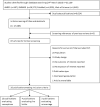Reproductive outcomes in women and men using complementary and alternative medicine treatment and not receiving artificial reproductive technology: a systematic review
- PMID: 33083872
- PMCID: PMC7960609
- DOI: 10.1007/s00404-020-05836-4
Reproductive outcomes in women and men using complementary and alternative medicine treatment and not receiving artificial reproductive technology: a systematic review
Erratum in
-
Correction to: Reproductive outcomes in women and men using complementary and alternative medicine treatment and not receiving artificial reproductive technology: a systematic review.Arch Gynecol Obstet. 2021 Mar;303(3):837. doi: 10.1007/s00404-020-05891-x. Arch Gynecol Obstet. 2021. PMID: 33241442 Free PMC article. No abstract available.
Abstract
Purpose: Infertility is a global problem, but only a minority of couples access assisted reproductive technologies due to financial and sociocultural barriers. Complementary and alternative medicine are seen as another option. We aimed to determine the impact of complementary and alternative medicine on conception, miscarriage and live birth rates in couples not receiving assisted reproductive technology treatments.
Methods: The electronic databases EMBASE, PubMed, Web of Science and the Allied and Complementary Medicine Database were systematically searched before March 24th 2020. Reference lists of eligible studies were searched for relevant studies. Eligible studies included trials and observational studies that assessed a complementary or alternative medicine and conception, miscarriage or live births in men or women not undergoing fertility treatment. Data were extracted by two independent reviewers using a pre-designed data collection form. The study protocol was published in the PROSPERO database (CRD42018086980).
Results: Twenty randomized controlled trials were identified, including 2748 individuals. Most studies did not demonstrate any effect of a complementary or alternative medicine on pregnancy, live birth or miscarriage rates. Limited evidence was found for a positive effect of herbal therapies taken by women on conception rates. There was substantial diversity in quality across the studies.
Conclusion: There is limited evidence of the effectiveness of complementary and alternative medicine on improving the chances of conception and live births, or increasing miscarriage risk. Owing to the generally sub-optimal quality and heterogeneous nature of the evidence, rigorous studies are needed to determine the impact of complementary and alternative medicine on fertility.
Keywords: Alternative medicine; Complementary medicine; Conception; Live births; Miscarriage; Pregnancy.
Conflict of interest statement
Dr Quenby reports grants from Tommy's baby Charity, during the conduct of the study. CO, EB, AH, CS, WW, ACC, HMY declare that they have no competing interests.
Figures




References
Publication types
MeSH terms
LinkOut - more resources
Full Text Sources
Medical

